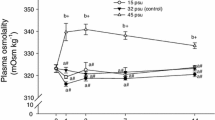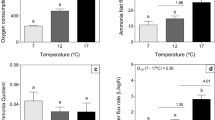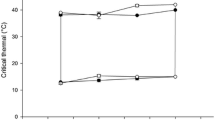Summary
The krill Euphausia superba, unlike the amphipod, Eusirus antarcticus, tolerates being frozen into solid sea-ice at temperatures down to about-4°C. Cooled in air, the amphipod and the krill freeze and will die at temperatures of-11° and-9°C respectively, representing the supercooling points of the animals. The krill is an osmoconformer in the salinity range of 25 to 45 ppt, while the amphipod conforms in the salinity range of 26 to 40 ppt. The animals thereby lower the melting point of their body fluids in the vicinity of the freezing sea ice, preventing internal ice formation at low temperatures. The mean oxygen consumption rates, at raised and lowered salinities, were not significantly different from rates obtained in normal (35 ppt.) seawater, indicating that salinity has little effect on the metabolism of either species.
Similar content being viewed by others
References
Aarset AV, Aunaas T (1987a) Osmotic responses to hyposmotic stress in the amphipods Gammarus wilkitzkii. Onisimus glacialis and Parathemisto libellula from Arctic waters. Polar Biol 7:189–193.
Aarset AV, Aunaas T (1987b) Physiological adaptations to low temperature and brine exposure in the circumpolar amphipod Gammarus wilkitzkii. Polar Biol 8:129–33
Aarset AV, Willumsen FV (1985) Hydraulic based sampling equipment for under-ice fauna. Polar Res 3:253–255
Andreas EL, Ackley SF (1982) On the differences in ablation seasons on the Arctic and Antarctic sea ice. J Atmos Sci 39:440–447
Andriashev AP (1968) The problem of the life community associated with the Antarctic fast ice. In: Currie RI (ed) Symposium on Antarctic oceanography. Heffer & Sons, Cambridge, pp 147–169
Carey AG Jr (1985) Marine ice fauna: Arctic. In: Horner RA (ed) Sea ice biota. CRC Press, Florida, pp 173–190
Childress JJ (1971) Respiratory adaptation to the oxygen minimum layer in the bathypelagic mysid Gnathophausia ingens. Biol Bull Mar Biol Lab (Woods Hole Mass) 149:109–121
Clarke LC (1956) Monitor and control of blood and tissue oxygen tensions. Trans Am Soc Art if Intern Organs 2:41–48
Cox GFN, Weeks WF (1974) Salinity variations in sea ice. J Glaciol 67: 109–120
Cross W (1982) Under ice biota at the Pond Inlet ice edge and in adjacent fast ice areas during spring. Arctic 35:13–27
De Vries AL (1971) Glycoproteins as biological antifreeze agents in the Antarctic fishes. Science 172:1152–1155
Dorgelo J (1977) Comparative ecophysiology of gammarids (Crustacea: Amphipoda) from marine, brachish-and freshwater habitats exposed to the influence of salinity-temperature combinations. IV. Blood serum regulation. Neth J Sea Res 11:184–199
Forward RB, Fyhn HJ (1983) Osmotic regulation of the krill Meganyctiphanes norvegica. Comp Biochem Physiol A 74:301–305
Gordon AL (1981) Seasonality of Southern Ocean sea ice. J Geophys Res 86:4193–4197
Green JM, Steele (1975) Observation of marine life beneath sea ice, Resolute Bay, NWT. Proc Circum Conf Nothern Eco 12:77
Gulliksen B (1984) Under-ice fauna from Svalbard waters. Sarsia 69: 17–23
Kinne O (1964) The effects of temperature and salinity on marine and brackish water animals. 2. Salinity and temperature-salinity combinations. Oceanogr Mar Biol 2:281–339
Maykut GA (1985) The ice environment. in: Horner R (ed) Sea ice biota. CRC Press, Florida, pp 21–82
Nansen F (1906) Protozoa from the ice-floes of the North Polar seas. Sci Res Norw N Polar Exp 5:1–22
Newbury TK (1983) Under landfast ice. Arctic 36:328–340
Rakusa-Suszczewski S, McWhinnie MA (1976) Resistance to freezing by Antarctic fauna: supercooling and osmoregulation. Comp Biochem Physiol A 54:291–300
Untersteiner N (1968) Natural desalination and equilibrium salinity profile of old sea ice. J Geophys Res 73:1251–1257
Wakatsuchi M, Ono N (1983) Measurements of salinity of brine excluded from growing sea ice. J Geophys Res 88:294–295
Weeks WF (1968) Understanding the variations of the physical properties of sea ice. Symp Antarct Ocean, Chile, Scott Pol Res Inst, pp 173–190
Zachariassen KE (1980) The role of polyols and nucleating agents in cold-hardy beetles. J Comp Physiol 140:227–234
Zachariassen KE, Husby JA (1982) Antifreeze effects of thermal hysteresis agents protects highly supercooled insects. Nature 298:865–867
Zachariassen KE, Baust JG, Lee RE (1982) A method for quantitative determination of ice nucleating agents in insect haemolymph. Cryobiology 19:180–184
Zwally HJ, Parkinson CL, Comiso JC (1983) Variability of Antarctic sea ice and changes in carbon dioxide. Science 220:1005–1012
Author information
Authors and Affiliations
Rights and permissions
About this article
Cite this article
Aarset, A.V., Torres, J.J. Cold resistance and metabolic responses to salinity variations in the amphipod Eusirus antarcticus and the krill Euphausia superba . Polar Biol 9, 491–497 (1989). https://doi.org/10.1007/BF00261032
Received:
Accepted:
Issue Date:
DOI: https://doi.org/10.1007/BF00261032




